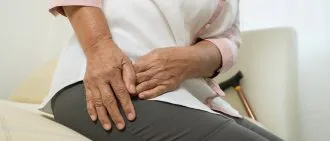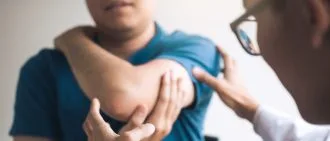Shoulder surgery has significantly improved in the past few decades. For injuries like rotator cuff and labral tears, surgeons are now more likely to use a less-invasive option called the arthroscopic approach.
“Arthroscopic surgery uses tiny incisions, a quarter-inch to a half-inch long, called ‘poke holes,'” says Nathan Wool, MD, a UPMC orthopaedic surgeon specializing in sports medicine.
“We use a tiny camera with a light on it that magnifies everything three to four times,” he says. “Then we use tiny instruments coming in from different angles to do the surgery.”
The arthroscopic approach is the least invasive technique for shoulder repair surgery. Surgeons can’t use this technique for joint replacement surgeries, Wool says, but “arthroscopic surgery is good for fixing or replacing ligaments or tendons in the joint.”
Never Miss a Beat!
Subscribe to Our HealthBeat Newsletter!
Thank you for subscribing!
You can now select the specific newsletters you'd like to receive.
You are already subscribed.
Subscribe to more newsletters in our email preference center.
Sorry, an error occurred. Please try again later.
Get Healthy Tips Sent to Your Phone!
Benefits of Arthroscopic Shoulder Surgery
Between knee surgeries and shoulder surgeries, Dr. Wool averages 100 or more arthroscopic procedures a year. In addition to his five-year orthopaedic residency, he did an additional year of fellowship training in sports medicine. “I spent that year doing almost nothing but arthroscopy,” Dr. Wool says.
That training matters because arthroscopic surgery is all about precision and technique. The surgeon has to understand exactly how to manipulate the arthroscopic tools.
This precision also benefits the person getting surgery — there’s less soft tissue damage during arthroscopic surgery. “Before, to fix a rotator cuff or labrum tear, we had to do an open surgery,” he says.
In open surgery, the surgeon would have to make as much as a 4-inch incision. To get to the joint, they’d often have to cut the tendon first and then repair it afterward.
“That meant a longer recovery,” Dr. Wool says. “But now, with arthroscopic surgery, there’s less damage to heal. It means you get back to a functional level more quickly.”
The Most Common Arthroscopic Shoulder Surgeries
The two most common arthroscopic shoulder surgeries Dr. Wool performs are:
- Labral tear repair.
- Rotator cuff repair.
Labral tears and rotator cuff tears are two distinct injuries. They tend to affect different populations and happen for different reasons.
Less invasive surgery for labral tear
The labrum is the ring of cartilage that keeps the ball of your arm bone in its shoulder socket. It’s what allows you to move your shoulder smoothly. When you injure that ring of cartilage, it’s a labral tear.
“Labral tears are associated with instability,” Dr. Wool says. “It can make your shoulder pop in and out of the socket.”
Labral tears are generally a young person’s injury. Dr. Wool says most people he sees with this injury are under 35 and usually athletes.
Labral tears in the front of the shoulder are most common in football and lacrosse. They tend to happen as a result of a shoulder dislocation, he says.
Labral tears in the back tend to happen when the shoulder pushes back. “Think offensive lineman in football,” Dr. Wool says. Bench pressing too much weight or overusing that “pressing” motion can also lead to a labral tear.
Overhead athletes, like baseball and tennis players, are also at risk. During Dr. Wool’s sports medicine fellowship at Beacon Orthopaedics & Sports Medicine in Cincinnati, he worked directly with Cincinnati Reds baseball players. “The overhead athletes with labral tears I see the most are baseball players,” he says.
The benefit of having a labral tear fixed arthroscopically is that it helps you retain more motion in your shoulder. “You have less scar tissue, so you can move your arm better, and rotate it externally,” he says.
You can imagine that for athletes, that range of motion is everything. “Imagine a wide receiver reaching up to make a catch. That’s external rotation,” he says.
Recovery for labral tears fixed arthroscopically is about six months for contact sports and up to five months for noncontact sports.
Less invasive surgery for rotator cuff tear
Four different tendons surround your shoulder joint. Together with muscles, these tendons make up your rotator cuff.
The rotator cuff keeps the top of your arm bone in your shoulder socket. It also helps you rotate and move your shoulder.
“Rotator cuff tears are typically an injury that affects middle-aged and older people,” Dr. Wool says. This is because the tendons that make up your rotator cuff wear with age.
“Our tendons are elastic, and as we get older, they lose water. This makes them more prone to cracking and tearing over time,” he explains.
You can tear your rotator cuff in a traumatic injury, like a direct hit or a car accident. But more commonly, he sees tears related to repetitive overhead arm motion.
“These happen more slowly like a rope fraying more each year,” he says. These tears usually cause chronic pain, which he defines as pain that lasts six to 12 months.
Rotator cuff pain tends to feel sharp. The classic rotator cuff test is whether it hurts to reach into the back seat of your car. Pain when reaching behind you or reaching up to grab something off a high shelf is usually the rotator cuff.
“It’s all about pain management,” Dr. Wool says. It’s possible to have a small tear without pain, so he doesn’t just go by the MRI. “I also see plenty of people who get better with anti-inflammatory medicine and physical therapy.”
Your recovery time for arthroscopic repair of the rotator cuff depends on the size of the tear. It’s usually between four and six months. As with most surgeries, people get the best results when they do physical therapy as part of their rehab.
Dr. Wool is based in Harrisburg, Pa., but also sees patients in Carlisle and Shippensburg. He advises that if you have shoulder pain, you should plan a visit with a sports medicine expert.
“People tend to avoid using their shoulder when they have pain. That creates a secondary problem, because it gets stiff,” he says. “Don’t wait too long.”
About UPMC Orthopaedic Care
When you are dealing with bone, muscle, or joint pain, it can affect your daily life. UPMC Orthopaedic Care can help. As a national leader in advanced orthopaedic care, we diagnose and treat a full range of musculoskeletal disorders, from the acute and chronic to the common and complex. We provide access to UPMC’s vast network of support services for both surgical and nonsurgical treatments and a full continuum of care. Our multidisciplinary team of experts will work with you to develop the treatment plan that works best for you. Our care team uses the most innovative tools and techniques to provide better outcomes. We also are leaders in research and clinical trials, striving to find better ways to provide our patients care. With locations throughout our communities, you can find a provider near you.





